Related Research Articles

Buffy the Vampire Slayer is a 1992 American comedy horror film directed by Fran Rubel Kuzui and starring Kristy Swanson, Donald Sutherland, Paul Reubens, Rutger Hauer, Luke Perry, Hilary Swank, and David Arquette. It follows a Valley Girl cheerleader named Buffy who learns that it is her fate to hunt vampires. It was a moderate success at the box office, but received mixed reception from critics. The film took a different direction from that which its writer, Joss Whedon, intended. Five years later, he created the darker, and critically acclaimed, television series of the same name.
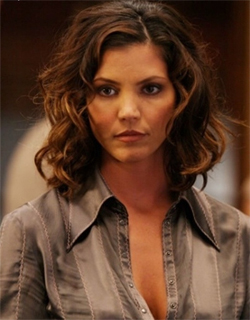
Cordelia Chase is a fictional character created by Joss Whedon for the television series Buffy the Vampire Slayer; she also appeared on Buffy's spin-off series, Angel. Portrayed by Charisma Carpenter, the character appears as a series regular in the first three seasons of Buffy, before leaving the show and becoming a series regular during the first four seasons of Angel. The character made her last television appearance in 2004, appearing as a special guest star in Angel's 100th episode. Cordelia also appears in both canonical and apocryphal Buffy and Angel material such as comic books and novels.

Willow Rosenberg is a fictional character created for the fantasy television series Buffy the Vampire Slayer (1997–2003). She was developed by Joss Whedon and portrayed throughout the TV series by Alyson Hannigan.
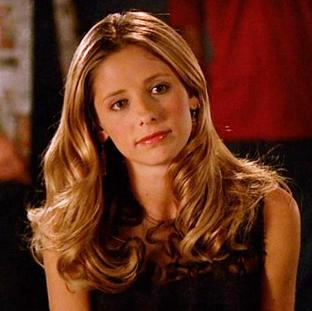
Buffy Anne Summers is the title character of the Buffy the Vampire Slayer franchise. She first appeared in the 1992 film Buffy the Vampire Slayer before going on to appear in The WB/UPN 1997–2003 television series and subsequent 1998–2018 Dark Horse and 2019–present Boom! Studios comic series of the same name. The character has also appeared in the spin-off series Angel, as well as numerous expanded universe materials such as novels and video games. Buffy was portrayed by Kristy Swanson in the film and by Sarah Michelle Gellar in the television series. Giselle Loren has lent her voice to the character in both the Buffy video games and an unproduced animated series, while Kelly Albanese lent her voice to the character in the Buffy the Vampire Slayer Season Eight motion comics.

Buffy the Vampire Slayer is an American supernatural drama television series created by writer and director Joss Whedon. It is based on the 1992 film of the same name, also written by Whedon, although they are separate and otherwise unrelated productions. Whedon served as executive producer and showrunner under his production tag Mutant Enemy Productions.

William "Spike" Pratt, played by James Marsters, is a fictional character created by Joss Whedon and David Greenwalt for the television series Buffy the Vampire Slayer and Angel. Spike is a vampire and played various roles on the shows, including villain, anti-hero, trickster and romantic interest. For Marsters, the role as Spike began a career in science fiction television, becoming "the obvious go-to guy for US cult [television]." For creator Whedon, Spike is the "most fully developed" of his characters. The character was intended to be a brief villain, with Whedon originally adamant to not have another major "romantic vampire" character like Angel. Marsters says "Spike was supposed to be dirty and evil, punk rock, and then dead." However, the character ended up staying through the second season, and then returning in the fourth to replace Cordelia as "the character who told Buffy she was stupid and about to die."
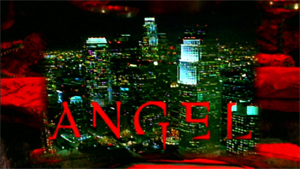
Angel is an American supernatural television series, a spinoff of Buffy the Vampire Slayer. The series was created by Buffy's creator, writer and director Joss Whedon, in collaboration with David Greenwalt. It aired on The WB from October 5, 1999, to May 19, 2004, consisting of five seasons and 110 episodes. Like Buffy, it was produced by Whedon's production company, Mutant Enemy.

Harmony Kendall is a fictional character created by Joss Whedon for the television series Buffy the Vampire Slayer and its spin-off Angel. The character is portrayed by Mercedes McNab. Originally cast as a minor character, McNab's credited status elevated to guest star and ultimately series regular over the course of her tenure in Buffy and Angel.
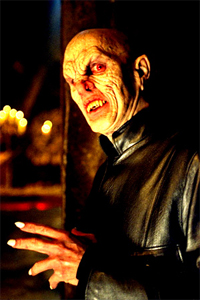
The Master is a fictional character on the action-horror/fantasy television series Buffy the Vampire Slayer (1997–2003). He is a centuries-old vampire portrayed by Mark Metcalf, determined to open the portal to hell below Sunnydale High School in the fictional town of Sunnydale where the main character Buffy Summers lives. The premise of the series is that Buffy is a Slayer, a teenage girl endowed with superhuman strength and other powers, which she uses to kill vampires and other evil beings. Each season of the series Buffy and the small group of family and friends who work with her, nicknamed the Scooby Gang, must defeat an evil force referred to as the Big Bad; the villain is usually trying to bring on an apocalypse. The Master is the first season's Big Bad.
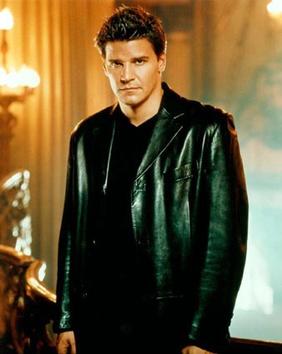
Angel is a fictional character created by Joss Whedon and David Greenwalt for the American television programs Buffy the Vampire Slayer and its spin-off series Angel. The character is portrayed by actor David Boreanaz. As introduced in Buffy in 1997, Angel is a love interest for heroine Buffy Summers, a young woman whose destiny as "the Slayer" is to fight the forces of evil, such as vampires and demons. However, their relationship is complicated by the fact that Angel is himself a vampire cursed with remorse and a human soul, which motivates him to assist Buffy in her duties as Slayer. The character's popularity led to the production of the spin-off Angel, which follows the character's struggle towards redemption after moving to Los Angeles. In addition to the two television series, the character appears in the comic book continuations of both series, as well as much other expanded universe literature.

Vampire films have been a staple in world cinema since the era of silent films, so much so that the depiction of vampires in popular culture is strongly based upon their depiction in films throughout the years. The most popular cinematic adaptation of vampire fiction has been from Bram Stoker's 1897 novel Dracula, with over 170 versions to date. Running a distant second are adaptations of the 1872 novel Carmilla by Sheridan Le Fanu. By 2005, the Dracula character had been the subject of more films than any other fictional character except Sherlock Holmes.
"Faith, Hope & Trick" is the third episode of season three of the television show Buffy the Vampire Slayer. This episode introduces the character Faith, another vampire slayer, who will become a key player in Sunnydale. While the rest of the gang gets to know Faith, Giles suspects that Faith and Buffy aren't being entirely honest about recent events in their lives. Some new vampires arrive in Sunnydale with their own agendas and a familiar face returns. It was written by David Greenwalt, directed by James A. Contner, and first broadcast on The WB on October 13, 1998.
"City Of is the series premiere of the television series Angel. Written by co-creators Joss Whedon and David Greenwalt and directed by Whedon, it was originally broadcast on October 5, 1999 on the WB network.
"Spin the Bottle" is episode 6 of season 4 in the television show Angel. Written and directed by series creator Joss Whedon, it was originally broadcast on November 10, 2002 on the WB television network. In "Spin the Bottle", Lorne performs a magic spell on Cordelia to help her regain her memory, but instead the spell causes all the Angel Investigations members to revert to their teenage personae.

"Bad Blood" is a story arc that ran through Buffy the Vampire Slayer #9–11, 13–15, and 17–19, based on the Buffy the Vampire Slayer television series. The arc was later collected into trade paperback editions, three issues to a volume.

The non-broadcast pilot episode of Buffy the Vampire Slayer was produced by 20th Century Fox Television in 1996 to pitch a series to networks. The twenty-five-and-a-half-minute production was written and directed by Buffy creator Joss Whedon, and was expanded upon and re-shot for the first episode of the series. It is notable for featuring different actors in the roles of Willow and Principal Flutie. Sunnydale High is known as Berryman High.
"Welcome to the Hellmouth" is the series premiere of the American supernatural drama television series Buffy the Vampire Slayer. It originally aired on The WB on March 10, 1997 in a two-hour premiere along with the following episode, "The Harvest". The episode was written by the series creator and executive producer Joss Whedon and directed by Charles Martin Smith. "Welcome to the Hellmouth" received a Nielsen rating of 3.4 upon its original airing and received largely positive reviews from critics.
"The Harvest" is the second episode of the first season of the American supernatural drama television series Buffy the Vampire Slayer. It was written by series creator executive producer Joss Whedon and directed by John T. Kretchmer. The episode originally aired on The WB on March 10, 1997, forming a two-hour premiere with the previous episode, "Welcome to the Hellmouth", and attracted 3.4 million viewers.
Buffy the Vampire Slayer is an ongoing comic book series published by Boom! Studios. It is a reboot of the television series Buffy the Vampire Slayer created by Joss Whedon, and thus sets in a different canon from the television series'. The series is written by Jordie Bellaire and primarily illustrated by Dan Mora.
References
- 1 2 "Haute Black". The Plain Dealer. Cleveland. January 3, 2007.
- 1 2 3 4 5 6 "Face up to avant garde". The Straits Times. Singapore. August 3, 2000.
- 1 2 3 Lydia Martin (April 25, 1995). "Hot Fashion Tips: Black-as-Night Nails Vamp It Up". The Miami Herald.
- ↑ "The Most Lucrative Form of Flattery". New York Times. October 7, 2013. p. E3.(subscription required)
- ↑ "Fashion Notes". Fort Worth Star-Telegram. August 24, 1995.
- ↑ "Team Players". New York Magazine: 119. September 11, 1995.
- ↑ Carole Watson (December 3, 2002). "Book Paints Makeup Biz in New Light". New York Post.
- ↑ Lucy Howard; Carla Koehl (April 22, 1996). "Pigments for a post-vamp era". Newsweek. 127 (17).
- 1 2 Victoria Sherrow (January 1, 2001). For Appearance' Sake: The Historical Encyclopedia of Good Looks, Beauty, and Grooming. Greenwood Publishing Group. p. 119. ISBN 978-1-57356-204-1 . Retrieved September 25, 2021.
- 1 2 Melinda Davis (October 21, 2002). The New Culture of Desire: 5 Radical New Strategies That Will Change Your Business and Your Life. Simon and Schuster. p. 124. ISBN 978-0-7432-4790-0.
- ↑ "Nails: Metallica". Vibe: 128. November 1996.
- ↑ "Tarantino's Pulp Fiction and Baudrillard's Perfect Crime". International Journal of Baudrillard Studies. 10 (1). January 2013. Retrieved April 18, 2014.
- ↑ Rita Ponweiser. Kulturspezifika und Anspielungen in der multimedialen Übersetzung am Beispiel der amerikanischen Fernsehserie "Buffy the Vampire Slayer" (Masterarbeit) (PDF). Universität Wien. p. 61. Retrieved April 18, 2014.
Cordelia: [...] If you hang with me and mine, you'll be accepted in no time. Of course, we do have to test your coolness factor. You're from L.A., so you can skip the written, but let's see. Vamp nail polish.
Buffy: Um, over?
Cordelia: So over. James Spader.
Buffy: He needs to call me!